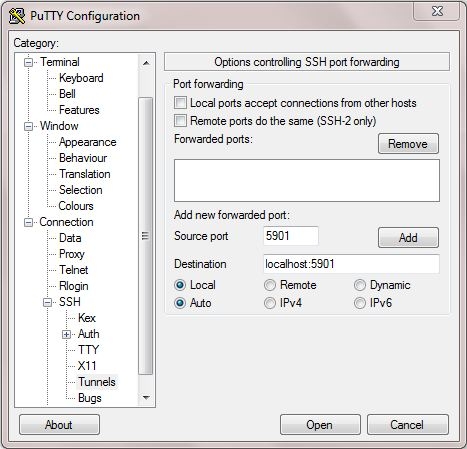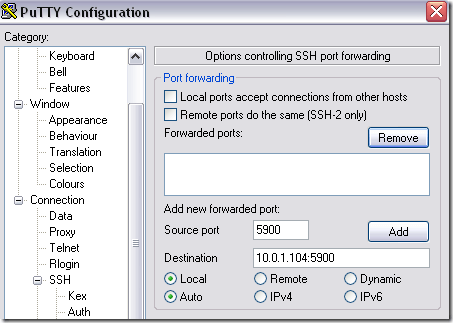

VNC uses a 'display number' which, when added to 5900, yields the port number used by the. Enable compression to make the session faster.

Use the IP address of the remote computer you are connecting to.

#SSH TUNNEL VNC HOW TO#
As Im not 100 sure on how this works, Ill explain it to the best of my knowledge. How to connect to a VNC session through a tunnel using putty Create a session profile. You wouldnt be using your WAN IP address with the VNC app to connect. Plink.exe –L 5904:localhost:5904 command opens an SSH shell once logged on. In order for the VNC app to tunnel thru the SSH connection you have to specifically tell it to. then launch your vnc instance with: vncserver.
#SSH TUNNEL VNC INSTALL#
vnc4server can be installed on your server with: sudo apt-get install vnc4server. This question was answered by sierracircle: correct. Configure this client to connect to the SSH server on machine B, and to forward connections that come to port 5900 on the client machine to port 5900 on machine A. The script just makes an SSH tunnel for the VNC session and then opens the. To set up a tunnel to port 5904 (and hence to the VM that listens on that port) - as described above – run the following CLI command: In order to securely access the VNC server from a client machine, you need to perform the following steps: Equip the client machine with an SSH port forwarding client. It is possible to set up SSH tunnels using command line utility plink.exe that comes with PuTTY in Windows. Run a VNC viewer (such as UltraVNC – ) and configure a connection to a tunnel port on the local host – refer the following screen shot: On the client side it seems like I can connect, at least it doesnt throw any obvious error message. Save the session and log on to XenServer – this sets up the tunnels configured above. When I disconnected the VNC (client side) an error messaged showed up (server side) that says System program problem detected and this message shows up every two minutes or so. With this handy networking tool, you can tunnel VNC through SSH, so not only are you not punching through the VNC port, but you’re sending all. Where vncterm in the above output is used by Linux VMs and qemu-dm by Windows VMs.ĭownload and configure your PuTTY SSH client ( ) with (multiple) tunnels as shown in the following screen shot: Fortunately, you have Secure Shell (SSH) to lean on. Tcp 0 0 127.0.0.1:5901 0.0.0.0:* LISTEN 6564/qemu-dm The connection will now be directed through the SSH tunnel, so you need to close the ports open for VNC. Using the Graphical User Interface In XenServer, all VNC connectors inside Dom0 listen on ports starting from 5900 (Dom0 itself), 5901 (first VM), and so on.


 0 kommentar(er)
0 kommentar(er)
